
Corydoras is a genus of freshwater catfish in the family Callichthyidae and subfamily Corydoradinae. The species usually have more restricted areas of endemism than other callichthyids, but the area of distribution of the entire genus almost equals the area of distribution of the family, except for Panama where Corydoras is not present. Corydoras species are distributed in South America where found east of the Andes to the Atlantic coast, from Trinidad to the Río de la Plata drainage in northern Argentina. Species assigned to Corydoras display a broad diversity of body shapes and coloration. Corydoras are small fish, ranging from 2.5 to 12 cm in SL., and are protected from predators by their body armor and by their sharp, typically venomous spines.

The bronze corydoras, green corydoras, bronze catfish, lightspot corydoras or wavy catfish is a tropical freshwater fish in the "armored catfish" family, Callichthyidae, often kept in captivity by fish keepers. It is widely distributed in South America on the eastern side of the Andes, from Colombia and Trinidad to the Río de la Plata basin. It was originally described as Hoplosoma aeneum by Theodore Gill in 1858 and has also been referred to as Callichthys aeneus.

Corydoras panda is a species of catfish belonging to the genus Corydoras, of the family Callichthyidae, and is a native member of the riverine fauna of South America. It is found in Peru and Ecuador, most notably in the Huanaco region, where it inhabits the Rio Aquas, the Rio Amarillae, a tributary of the Rio Pachitea, and the Rio Ucayali river system. The species was first collected by Randolph H. Richards in 1968, and was named Corydoras panda by Nijssen and Isbrücker in 1971. The specific name is an allusion to the appearance of the fish, which possesses large black patches surrounding the eyes, reminiscent of those found on the giant panda. Accordingly, the common names for this fish, which is a popular aquarium species, are panda corydoras and panda catfish.

The spotted corydoras, longnose corydoras or Agassiz's catfish is a tropical freshwater fish belonging to the subfamily Corydoradinae of the family Callichthyidae. It originates in inland waters in South America, and is found in the upper Amazon River basin in Brazil, Colombia and Peru.
The blackstripe corydoras or Bond's catfish is a tropical freshwater fish belonging to the Corydoradinae sub-family of the family Callichthyidae. It originates in inland waters in South America, and is found in the Yuruarí River in Venezuela and the Corantijn and Rupununi River basins in Guyana and Suriname. In the system of "C-Numbers" developed by the German fishkeeping magazine DATZ to identify undescribed species of Corydoras in the aquarium hobby, this fish had been assigned number "C31" until it was correctly identified.
The barredtail corydoras or Cochu's catfish is a tropical freshwater fish belonging to the Corydoradinae sub-family of the family Callichthyidae. It originates in inland waters in South America, and is found in the Upper Araguaia River basin in Brazil. In the system of "C-Numbers" developed by the German fishkeeping magazine DATZ to identify undescribed species of Corydoras in the aquarium hobby, this fish had been assigned number "C22" until it was correctly identified.
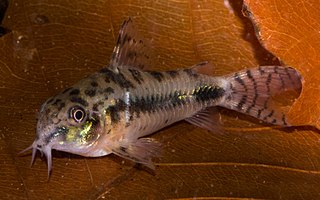
The salt and pepper catfish is a tropical freshwater fish belonging to the Corydoradinae sub-family of the family Callichthyidae. It originates in inland waters in South America, and is found in the Upper Orinoco River basin in Venezuela and Colombia.
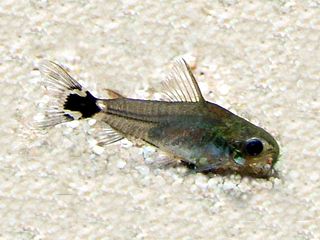
The dwarf corydoras, dwarf catfish, tail spot pygmy catfish, or micro catfish is a tropical freshwater fish belonging to the subfamily Corydoradinae of the family Callichthyidae. It originates in inland waters in South America, and is found in the Amazon River and Paraguay River basins in Argentina, Bolivia, and Brazil. The specific epithet hastatus means with a spear, in reference to the spearhead-like spot on the tail root.

The green gold catfish is a tropical freshwater fish belonging to the Corydoradinae subfamily of the family Callichthyidae. It originates in inland waters in South America, and is found in the Meta River basin in Colombia.

The masked corydoras, bandit catfish, bandit corydoras, or Meta River corydoras, Corydoras metae, is a tropical freshwater fish belonging to the Corydoradinae sub-family of the family Callichthyidae. It originates in inland waters of South America, and is found in the Meta River basin in Colombia.
Corydoras nanus is a tropical freshwater fish belonging to the Corydoradinae sub-family of the family Callichthyidae. It originates in inland waters in South America, and is found in the Suriname and Maroni River basins in Suriname and the Iracoubo River basin in French Guiana.
Corydoras osteocarus is a tropical freshwater fish belonging to the Corydoradinae sub-family of the family Callichthyidae. It originates in South America, and is found in the Orinoco River basin in Venezuela and coastal rivers in Suriname. In the system of "C-Numbers" developed by the German fishkeeping magazine DATZ to identify undescribed species of Corydoras in the aquarium hobby, this fish had been assigned number "C60" until it was correctly identified.
Corydoras polystictus is a tropical freshwater fish belonging to the Corydoradinae sub-family of the family Callichthyidae. It originates in inland waters in South America, and is found in the Paraguay River basin in Brazil.
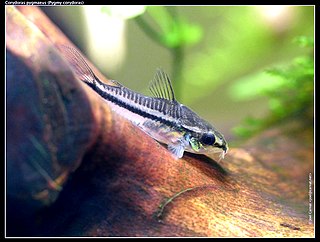
The pygmy corydoras or pygmy catfish is a tropical and freshwater fish belonging to the subfamily Corydoradinae of the family Callichthyidae. It originates in tropical inland waters in South America, and is found in the Madeira River basin in Brazil.
Corydoras reticulatus, also called the reticulated corydoras, mosaic corydoras, network catfish, or network corydoras, is a tropical freshwater fish belonging to the Corydoradinae sub-family of the family Callichthyidae. It originates in inland waters in South America, and is found in the Lower Amazon River basin in Brazil.
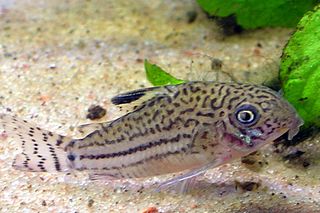
The three stripe corydoras, leopard catfish, false julii corydoras, or three line catfish is a tropical freshwater fish belonging to the subfamily Corydoradinae of the family Callichthyidae. It originates in inland waters in South America, and is found in the central Amazon River basin in Brazil and Colombia, Peruvian Amazon and coastal rivers in Suriname.
Corydoras undulatus is a tropical freshwater fish belonging to the Corydoradinae sub-family of the family Callichthyidae. It originates in inland waters in South America, and is found in the lower Paraná River basin and coastal rivers in southern Brazil and Argentina.
Britski's catfish is a tropical freshwater fish belonging to the subfamily Corydoradinae of the family Callichthyidae native to South America where it is found in the upper Paraguay River basin in Brazil. This species was formerly classified as Brochis britskii.

The hog-nosed catfish is a tropical freshwater fish belonging to the Corydoradinae sub-family of the family Callichthyidae. It is native to South America, and is found in the western Amazon basin in Ecuador and Peru. This species is traditionally placed in Brochis but the genus is a synonym of Corydoras. FishBase continues to recognize Brochis as a valid genus.
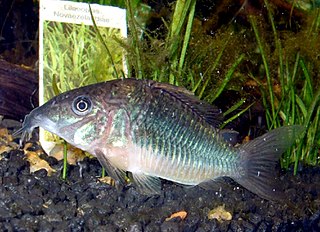
The emerald catfish is a tropical freshwater fish belonging to the Corydoradinae sub-family of the family Callichthyidae native to the Amazon Basin in South America. It has traditionally been known as Brochis splendens. The fish has appeared on a stamp in Brazil.












